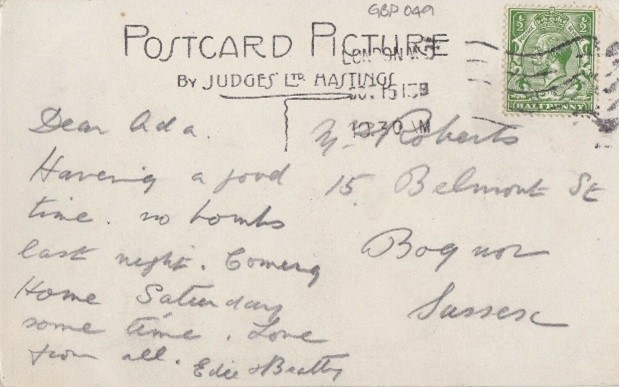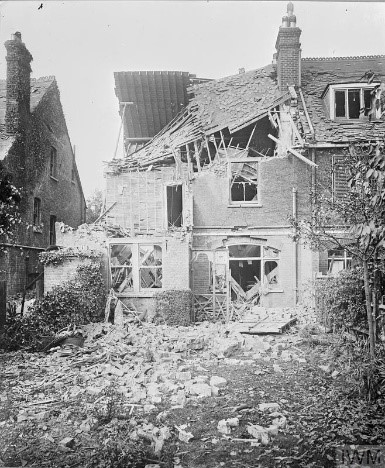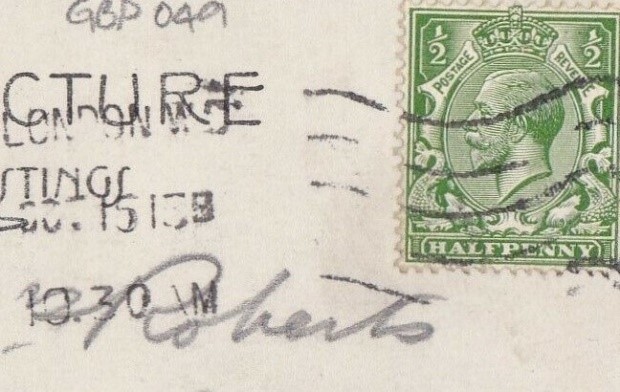Alyx King
The Shape of Things To Come …
On a sunny October morning in 1915, two young ladies, Edie and Beatty are taking in the crisp autumn air as they walk the streets of the West End of London. On their way, they will stop in at the main post office in New Oxford Street to drop off a postcard. Perhaps they will stop for morning tea at a café or tearoom along the way or book tickets for their return journey home at the London, Brighton & South Coast railway office.

Written on the card is a brief note to their friend, Mrs. Ada Roberts, the widowed landlady of the boarding house in Bognor (Regis) where the ladies have residence. The message informed her that they are having a good time, and that they will return home the following day, though they are not sure of the time. Another part of the message speaks of “no bombs last night,” referring to the bombs dropped by German Zeppelins less than 48-hours previous, on the night of October 13, 1915 – an event that would become known as the Theatreland Raid.
When people think of bombs falling on London, they tend to think of World War II, and the swarms of German aircraft flying overhead, unleashing the horror that today is remembered as the Blitz. But that was not the first time the great city was to endure such destruction.
At night on October 13, 1915, five  German Navy Zeppelins arrived over the Norfolk coast at about 6:30 PM. Unbeknownst to the Germans, to combat further threats from the air, new ground defence guns had been put in place, but these were to prove ineffective. One of the guns was a 13-pounder near Broxbourne. It was put out of action by three bombs dropped from Zeppelin L15.
German Navy Zeppelins arrived over the Norfolk coast at about 6:30 PM. Unbeknownst to the Germans, to combat further threats from the air, new ground defence guns had been put in place, but these were to prove ineffective. One of the guns was a 13-pounder near Broxbourne. It was put out of action by three bombs dropped from Zeppelin L15.
The airship continued to London and began bombing around Charing Cross. The first bombs struck the Lyceum Theatre and the corner of Exeter and Wellington Street, killing 17 and injuring another 20. Additional bombs fell on Holborn. As L15 approached Moorgate, it was engaged by a new 75 mm gun sited at the Honourable Artillery Company grounds in Finsbury. Some engine damage was inflicted, and the airship’s commander recognized the threat and ordered the ballast jettisoned to make its escape. In total the German airships killed 71 and injured 128 that night. This is a scenario that, some 25 years later, would become all too familiar to the people of London, as swarms of German aircraft would try and bomb Britain into submission.

It is this raid that our postcard senders are referring to and what I find odd is the off-handed way the remark appears, almost as an afterthought, sandwiched between “we are having a good time” and “we’ll be home tomorrow.” I will leave it to the reader to determine whether our two ladies are being very brave or were very shaken by the events of the previous few days.
* * *
The postcard is a black and white photograph card, entitled “Night Duty” Trafalgar Square 2 AM. As L17 in Judges Ltd, London night-time series, it was printed in 1910, which makes it one of the first to carry the name of “Judges Ltd.”

Judges Postcards was a picture postcard manufacturer based in St. Leonards-on-Sea, East Sussex, first produced by English photographer Fred Judge (1872-1950) in 1903. It was known as Judges Limited between 1910 and 1984.

* * *
I purchased the card from a well-known auction website, based purely on that wonderful picture. A bobby on his beat, talking to a passer-by, on a foggy night somewhere in London. So very full of atmosphere!
I also bought it in error, that’s right, in error. You see, when I first read the message on the back, I assumed it was a postcard from World War II, as it mentioned bombs dropping on London. In my defence, I am very new to postcard collecting, having recently progressed from stamps, via covers and first day covers, to PHQs (issued by the royal mail, they are postcards with the pictures of issued stamps on the front), and finally to postcards. After I had made the purchase, I was looking over the card again and suddenly realised that both the stamp, and the postmark, were wrong for a postcard from the early 1940s, and that this was in fact, much earlier but if that were true, what could this mention of bombs relate to?
Reading the description, it stated the card was from 1913, and at first glance, the postmark did indeed seem to confirm this. A postcard from 1913, sent from London, talking of bombs? It was time to put on my sleuthing cap and dig into this mystery.
First things first, I started by looking through London historic records for any mention of bombs or bombing in 1913, and right away, I fell upon the news reports of the letter bombing campaign by the suffragette movement. Result! Well, no. None of the dates matched up, so back to square one.
My next step was to share an image of the card (and the date) on a couple of stamp forums I am a member of. I got a few suggestions, and helpful hints, but it was only when some pointed out the that last 3 in the date looks more like a 5, that everything fell into place. The postcard was not from 1913, but 1915, October 15, 1915, two days after the theatre raid by the Zeppelins.

Now I had a date and the bombs mentioned made sense; the rest of the story was there in black and white. We know the names of the young ladies who sent the card, Edie, and Beatty, and the postcard starts Dear Ada, and not Mrs. Roberts, which points toward not only a degree of familiarity, such as you would see with friends or family, but also suggests a similar age group. A scan of the censor records for the address revealed that Mrs. Ada Roberts was a widow in her late 30s, who ran a boarding house.
The time on the card is 10:30 AM on the 15th (a Friday), and the message mentions no bombs last night. This points towards the postcard being written that morning and so it is likely dropped off at a post office, and not in a pillar box to await collection. Another feature of the postmark are the letters W.C. for Western Central, a postal district encompassing the West End, and whose district office was on New Oxford Street, as was home to many of the railway booking offices, and several cafés and tearooms.
The message also makes mention of the friends not knowing what time they will be arriving home on Saturday, so I think it not too far a stretch of the imagination to see our ladies planning on purchasing tickets for the return journey on the same walk as that of dropping off the postcard. The last piece of the puzzle, the weather, which came from a read through of the meteorological records that show it was a sunny, but chilly, morning with little wind.
I think I’ll leave this here. Every card tells a story, and sometimes they will throw up a surprise which takes you on an amazing journey of discovery.
Lovely writing. Interesting story with very useful research. Great story prompt for writer!
Looking forward to more contributions from Alyx after this interesting debut.
An outstanding article, has it all! Hope to see more from this author. Thanks Alyx.
A great story, Alyx, well told and very interesting I gather that if a card or letter was posted in a post box it would be postmarked with a later time of day.
Hello Mary, and thank for your kind words, and your question.
While my research is still ongoing, from what I have learnt so for, mail was collected at 6 A.M and again at 12 noon (Monday to Friday) during this time period.
While it is not impossible to suspect the ladies would be out for their morning walk prior to 6AM (to ensure the card arrived at a sorting office to receive it’s 10:45 AM postmark) I feel it would be an unlikely scenario.
Excellent research and reporting; brings long-ago moments to life, thank you!
Thisn was published in 2021, but I enjoyed reading the mystery and how the story unraveled. Lovely! and Thank You Very Mucj.